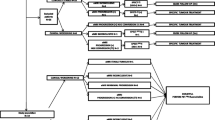Abstract
Objectives
To compare the diagnostic accuracy of contrast enhanced magnetic resonance imaging (Ce-MRI) and 18F-fluorodopa (18F-FDOPA) positron emission tomography (PET)-computed tomography (CT) for detecting recurrent glioma.
Methods
In this prospective study, 35 patients (age, 36.62 ± 0.86 years; 80 % male) with histopathologically proven glioma with clinical suspicion of recurrence were evaluated using Ce-MRI and 18F-FDOPA PET-CT. 18F-FDOPA PET-CT images were evaluated qualitatively and semi-quantitatively. Combination of clinical follow-up (minimum 1 year), repeat imaging and/or biopsy (when available) was taken as the reference standard.
Results
Based on the reference standard, 26 patients were positive and nine were negative for recurrence. The sensitivity, specificity and accuracy of Ce-MRI were 92.3 %, 44.4 % and 80 % respectively, whereas those of 18F-FDOPA PET-CT were 100 %, 88.89 % and 97.1 % respectively. Results of Ce-MRI and 18F-FDOPA PET-CT were concordant in 74.3 % (29/35) and discordant in 17.1 % of patients (6/35). On McNemar analysis the difference was not statistically significant overall (P = 0.687), for high-grade tumour (P = 0.5) or low-grade tumours (P = 1.0). However, 18F-FDOPA PET-CT was more specific than Ce-MRI overall (P = 0.0002), for high-grade tumour (P = 0.006) and low-grade tumours (P = 0.004).
Conclusion
F-FDOPA PET-CT shows a high but comparable diagnostic accuracy to Ce-MRI for the detection of recurrent glioma. However, it is more specific than Ce-MRI.
Key Points
• Recurrent glioma in the postoperative site remains a diagnostic dilemma.
• 18 F-FDOPA PET-CT shows high diagnostic accuracy for detecting recurrent glioma.
• Diagnostic accuracies for 18 F-FDOPA PET-CT and contrast enhanced MRI are comparable.
• However, 18 F-FDOPA PET-CT is more specific than Ce-MRI for recurrent glioma.





Similar content being viewed by others
References
Ginsberg LE, Fuller GN, Hashmi M, Leeds NE, Schomer DF (1998) The significance of lack of MR contrast enhancement of supratentorial brain tumours in adults: histopathological evaluation of a series. Surg Neurol 49:436–440
Mihara F, Numaguchi Y, Rothman M, Kristt D, Fiandaca M, Swallow L (1995) Non-enhancing supratentorial malignant astrocytomas: MR features and possible mechanisms. Radiat Med 13:11–17
Singhal T, Narayanan TK, Jain V, Mukherjee J, Mantil J (2008) 11C-L-methionine positron emission tomography in the clinical management of cerebral gliomas. Mol Imaging Biol 10:1–18
Laverman P, Boerman OC, Corstens FH, Oyen WJ (2002) Fluorinated amino acids for tumour imaging with positron emission tomography. Eur J Nucl Med Mol Imaging 29:681–690
Weber WA, Wester HJ, Grosu AL et al (2000) O-(2-[18F]fluoroethyl)-L-tyrosine and L-[methyl-11C]methionine uptake in brain tumours: initial results of a comparative study. Eur J Nucl Med 27:542–549
Becherer A, Karanikas G, Szabó M et al (2003) Brain tumour imaging with PET: a comparison between [18F]fluorodopa and [11C]methionine. Eur J Nucl Med Mol Imaging 30:1561–1567
Chen W, Silverman DH, Delaloye S et al (2006) 18F-FDOPA PET imaging of brain tumours: comparison study with 18F-FDG PET and evaluation of diagnostic accuracy. J Nucl Med 47:904–911
Ledezma CJ, Chen W, Sai V et al (2009) 18F-FDOPA PET/MRI fusion in patients with primary/recurrent gliomas: initial experience. Eur J Radiol 71:242–248
Fueger BJ, Czernin J, Cloughesy T et al (2010) Correlation of 6-18F-fluoro-L-dopa PET uptake with proliferation and tumour grade in newly diagnosed and recurrent gliomas. J Nucl Med 51:1532–1538
Füchtner F, Angelberger P, Kvaternik H, Hammerschmidt F, Simovc BP, Steinbach J (2002) Aspects of 6-[18F]fluoro-L-DOPA preparation: precursor synthesis, preparative HPLC purification and determination of radiochemical purity. Nucl Med Biol 29:477–481
Sharma P, Kumar R, Jeph S et al (2011) 18F-FDG PET-CT in the diagnosis of tumor thrombus: can it be differentiated from benign thrombus? Nucl Med Commun 32:782–788
Herholz K, Langen KJ, Schiepers C, Mountz JM (2012) Brain tumours. Semin Nucl Med 42:356–370
van Dellen JR, Danziger A (1978) Failure of computerized tomography to differentiate between radiation necrosis and cerebral tumour. S Afr Med J 53:171–172
Dooms GC, Hecht S, Brant-Zawadzki M, Berthiaume Y, Norman D, Newton TH (1986) Brain radiation lesions: MR imaging. Radiology 158:149–155
Ostergaard L, Hochberg FH, Rabinov JD et al (1999) Early changes measured by magnetic resonance imaging in cerebral blood flow, blood volume, and blood–brain barrier permeability following dexamethasone treatment in patients with brain tumours. J Neurosurg 90:300–305
Doyle WK, Budinger TF, Valk PE, Levin VA, Gutin PH (1987) Differentiation of cerebral radiation necrosis from tumour recurrence by [18F]FDG and 82Rb positron emission tomography. J Comput Assist Tomogr 11:563–570
Belohlávek O, Klener J, Vymazal J, Dbalý V, Tovarys F (2002) The diagnostics of recurrent gliomas using FDG-PET: still questionable? Nucl Med Rev Cent East Eur 5:127–130
Yee RE, Cheng DW, Huang SC, Namavari M, Satyamurthy N, Barrio JR (2001) Blood–brain barrier and neuronal membrane transport of 6-[18F]fluoro-L-DOPA. Biochem Pharmacol 62:1409–1415
Stout DB, Huang SC, Melega WP, Raleigh MJ, Phelps ME, Barrio JR (1998) Effects of large neutral amino acid concentrations on 6-[F-18]Fluoro-L-DOPA kinetics. J Cereb Blood Flow Metab 18:43–51
Luxen A, Guillaume M, Melega WP, Pike VW, Solin O, Wagner R (1992) Production of 6-[18F]fluoro-L-dopa and its metabolism in vivo—a critical review. Int J Rad Appl Instrum B 19:149–158
Beuthien-Baumann B, Bredow J, Burchert W et al (2003) 3-O-Methyl-6-[18F]fluoro- L-DOPA and its evaluation in brain tumour imaging. Eur J Nucl Med Mol Imaging 30:1004–1008
Oldendorf WH, Szabo J (1976) Amino acid assignment to one of the three blood–brain barrier amino acid carriers. Am J Physiol 230:94–98
Rose S, Fay M, Thomas P et al (2012) Correlation of MRI-derived apparent diffusion coefficients in newly diagnosed gliomas with [18F]-Fluoro-L-Dopa PET: what are we really measuring with minimum ADC? AJNR Am J Neuroradiol. doi:10.3174/ajnr.A3315
Holodny AI, Makeyev S, Beattie BJ, Riad S, Blasberg RG (2010) Apparent diffusion coefficient of glial neoplasms: correlation with fluorodeoxyglucose-positron-emission tomography and gadolinium-enhanced MR imaging. AJNR Am J Neuroradiol 31:1042–1048
Author information
Authors and Affiliations
Corresponding author
Rights and permissions
About this article
Cite this article
Karunanithi, S., Sharma, P., Kumar, A. et al. Comparative diagnostic accuracy of contrast-enhanced MRI and 18F-FDOPA PET-CT in recurrent glioma. Eur Radiol 23, 2628–2635 (2013). https://doi.org/10.1007/s00330-013-2838-6
Received:
Revised:
Accepted:
Published:
Issue Date:
DOI: https://doi.org/10.1007/s00330-013-2838-6




